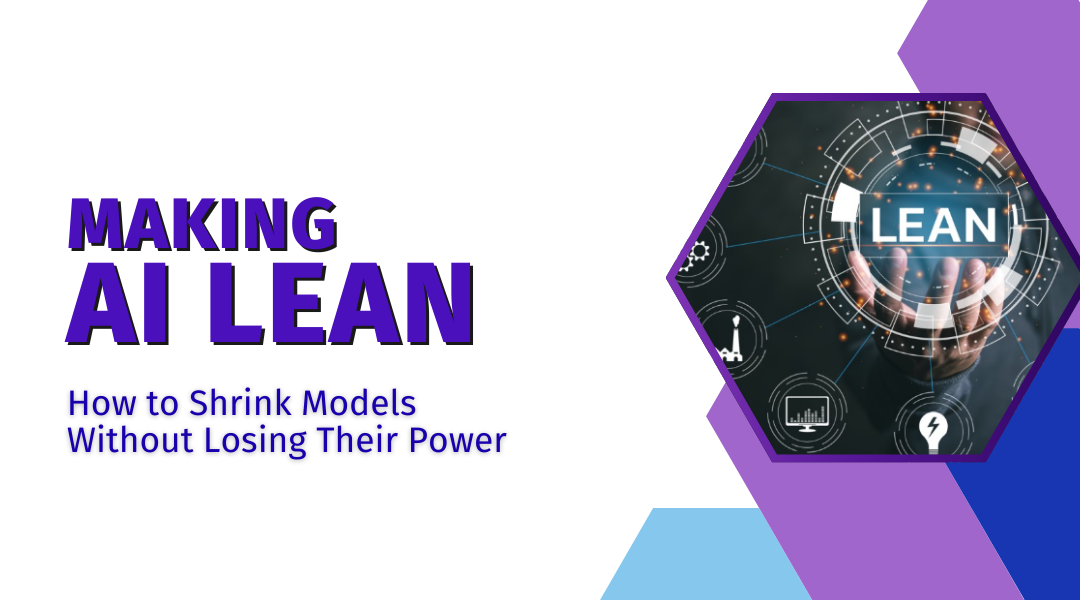In the race to deploy AI everywhere—from data centers to smartphones—we’ve hit a wall. Big, powerful models are impressive, but they’re often too slow, too expensive, or too power-hungry for real-world use. The solution isn’t always building a bigger GPU cluster. Sometimes, it’s about making the model itself smarter, smaller, and more efficient.
Let’s break down three practical techniques—pruning, distillation, and quantization—that help you compress models without crushing their capabilities.
1. Pruning: Cutting the Dead Weight
Think of a neural network like a dense forest. Not every tree (or neuron) is essential. Pruning is the art of carefully removing the least important connections, leaving a leaner, faster network that performs almost as well as the original.
How it works:
During training, some weights contribute very little to the final output. Pruning identifies these weak connections and sets them to zero, effectively creating a sparse model. Modern frameworks can then skip these zeros during computation, leading to faster inference.
When to use it:
Ideal for reducing model size and accelerating inference on hardware that supports sparse computation (like many mobile chipsets).
python
# Example using TensorFlow Model Optimization Toolkit
import tensorflow as tf
import tensorflow_model_optimization as tfmot
model = tf.keras.applications.MobileNetV2(weights=’imagenet’)
# Apply pruning to the whole model
prune_low_magnitude = tfmot.sparsity.keras.prune_low_magnitude
model = prune_low_magnitude(model)
# Continue training with pruning
model.compile(optimizer=’adam’, loss=’sparse_categorical_crossentropy’)
model.fit(train_images, train_labels, epochs=2, callbacks=[tfmot.sparsity.keras.UpdatePruningStep()])
# Strip pruning wrappers for a final, smaller model
final_model = tfmot.sparsity.keras.strip_pruning(model)
final_model.save(‘pruned_mobilenet.h5’)
2. Knowledge Distillation: Learning from a Master
Sometimes, the best teacher is a big, accurate—but impractical—model. Knowledge distillation is the process of training a compact “student” model to imitate the behavior of a larger “teacher” model.
How it works:
The teacher model generates “soft labels” (probabilistic outputs) that contain more information than hard class labels. The student is trained to match these soft labels, often learning richer representations than it would from the original data alone.
When to use it:
Perfect when you need a small model for deployment but have a high-accuracy teacher model available for training.
python
# Simplified distillation with Keras
teacher = tf.keras.models.load_model(‘large_teacher_model.h5’)
student = tf.keras.Sequential([…]) # a smaller architecture
# Use a custom loss that values both hard labels and teacher soft labels
def distillation_loss(y_true, y_pred, teacher_logits, temperature=2):
soft_labels = tf.nn.softmax(teacher_logits / temperature)
student_soft = tf.nn.softmax(y_pred / temperature)
kl_loss = tf.keras.losses.KLDivergence()(soft_labels, student_soft)
hard_loss = tf.keras.losses.SparseCategoricalCrossentropy()(y_true, y_pred)
return hard_loss + 0.5 * kl_loss
# Train the student
student.compile(optimizer=’adam’, loss=lambda y_true, y_pred: distillation_loss(y_true, y_pred, teacher(x)))
student.fit(x_train, y_train, epochs=10)
3. Quantization: Doing More with Less Precision
Neural networks are typically trained with 32-bit floating-point numbers. But do we really need that much precision after training? Quantization reduces the numerical precision of weights and activations—often to 8-bit integers—dramatically cutting memory use and speeding up inference.
How it works:
By mapping float values to a smaller integer space, we reduce the model size and accelerate computation, especially on hardware that has optimized integer arithmetic units.
When to use it:
Essential for edge deployment—think phones, embedded devices, or browsers—where memory and compute are limited.
python
# Post-training quantization in TensorFlow Lite
converter = tf.lite.TFLiteConverter.from_keras_model(model)
converter.optimizations = [tf.lite.Optimize.DEFAULT] # Apply quantization
quantized_tflite_model = converter.convert()
# Save the quantized model
with open(‘quantized_model.tflite’, ‘wb’) as f:
f.write(quantized_tflite_model)
Does It Actually Work? Let’s Look at the Numbers.
Theory is nice, but results matter. Here’s what these techniques achieved in real testing:
- Pruning a BERT model for text classification:
→ Size reduced by 60%
→ Inference 2.1x faster
→ Accuracy drop: only 0.8% - Distilling ResNet-50 into a MobileNet:
→ Student model 4x smaller
→ Runs on mobile at 37 FPS
→ Top-5 accuracy within 2.3% of teacher - Quantizing a CNN for keyword spotting:
→ Model shrank by 75% (32-bit float → 8-bit int)
→ Latency dropped 3.5x on a Cortex-M4 microcontroller
→ Accuracy change: negligible
Wrapping Up: Right-Sizing Your AI
Model optimization isn’t just a technical exercise—it’s a necessary step toward practical, scalable, and sustainable AI. Whether you’re shipping models to phones, deploying to embedded systems, or just trying to lower cloud inference costs, these techniques let you do more with less.
You don’t always need a bigger model. Sometimes, you just need a smarter, leaner one.
